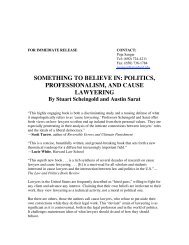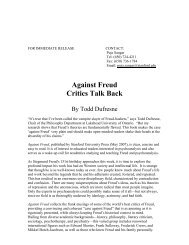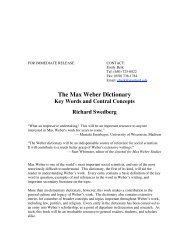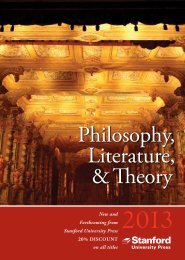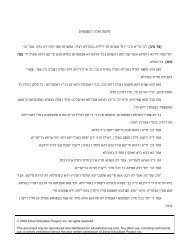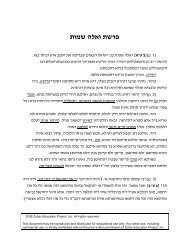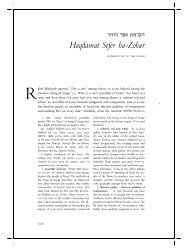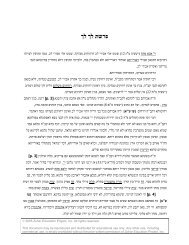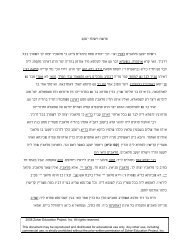Front Matter (PDF) - Stanford University Press
Front Matter (PDF) - Stanford University Press
Front Matter (PDF) - Stanford University Press
Create successful ePaper yourself
Turn your PDF publications into a flip-book with our unique Google optimized e-Paper software.
probably continuingto have a larger followingthan did Kabbalah.<br />
century,<br />
of the Zohar also reached Italy, the Byzantine lands of the eastern<br />
Manuscripts<br />
and the Holy Land duringthis period.<br />
Mediterranean,<br />
was after the expulsion of Spanish Jewry in 1492 that the in¯uence of<br />
It<br />
entered a period of rapid growth. Various explanations have been<br />
Kabbalah<br />
for this increased interest in the mystical tradition. Some have attrib-<br />
offered<br />
it to the sufferingand despair that visited this once proud group of Jewish<br />
uted<br />
in the period between 1391 and 1492. The devastation of the age,<br />
communities<br />
it is said, caused Jews to seek out deeper resources of consolation than those<br />
so<br />
by the typically optimistic worldview of the philosophers. Others claim<br />
offered<br />
the growth of Kabbalah came as a response of a different sort to the<br />
that<br />
expulsion. Jews throughout the Mediterranean world, including many<br />
Spanish<br />
exiles, were shocked and disgraced by the high numbers of Spanish<br />
Spanish<br />
who converted to Christianity in the course of the ®fteenth century. Once<br />
Jews<br />
the blame was placed partly at the door of philosophy, the intellectual<br />
again<br />
of Spanish Jewry havingsupposedly led to a laxity in religious<br />
sophistication<br />
and a relative indifference to the question of religious identity. Yet<br />
observance<br />
view attributes the growth in Kabbalah's in¯uence to the new home<br />
another<br />
in which former Iberian Jews found themselves. Ottoman Turkey, with<br />
cultures<br />
closed millet systemÐin which each faith community held fast to exclusive<br />
its<br />
and total denigration of all outside in¯uencesÐwas a hospitable<br />
truth-claims<br />
for precisely the closed-minded Zoharic view of the outside<br />
environment<br />
rather than the Aristotelian quasi-universalism of the philosophers,<br />
world,<br />
had served the needs of a very different age.<br />
which<br />
the reason (and a combination of the above factors is most<br />
Whatever<br />
we begin to see new kabbalistic works written and old ones distributed<br />
likely),<br />
explicated in the early sixteenth century. The Zohar and other works of the<br />
and<br />
tradition are especially prominent in this period. Perhaps typical is<br />
Castilian<br />
®gure of Rabbi Meir ibn Gabbai, a Turkish kabbalist who tells us that he<br />
the<br />
born in Spain in 1481 and left as a child amongthe exiles. Ibn Gabbai's<br />
was<br />
opus, Avodat ha-Qodesh (Venice, 1567), is a grand systematization of<br />
magnum<br />
and a defense of it against philosophy. Typically of the sixteenth<br />
Kabbalah<br />
Ibn Gabbai knows a great many earlier texts and seeks to harmonize<br />
century,<br />
with one another. But the great source of kabbalistic truth is the Zohar,<br />
them<br />
he quotes on virtually every page as ``the Midrash of Rabbi Shim'on son<br />
which<br />
Yoḥai.'' of<br />
kabbalistic conventicles of Safed, which ¯ourished in the late sixteenth<br />
The<br />
also accorded to the Zohar top place as the authoritative source of<br />
century,<br />
truth. Clearly, the choice of Safed as a place of settlement for Jews<br />
kabbalistic<br />
to the kabbalistic legacy had much to do with its proximity to Meron,<br />
attached<br />
supposed burial place of Rabbi Shim'on son of Yoḥai. His tomb had been a<br />
the<br />
of pilgrimage for local Jews long earlier, but with the growth of the Safed<br />
site<br />
Introduction<br />
lxxii<br />
community it became a truly important shrine. Both Rabbi Moses Cordovero



